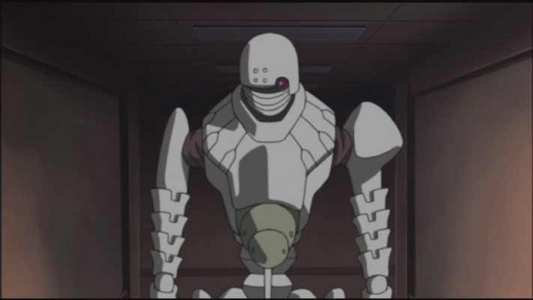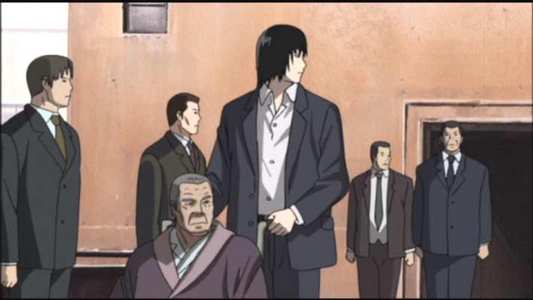Review of Texhnolyze: Vol. 4
Introduction
It`s been a protracted wait of nearly half a year for the latest volume in this stylish series from MVM, so long in fact that I had to pop Volume 3 back into the player to get a quick reminder of what has happened so far. But with a show like Texhnolyze, I don`t really need an excuse to watch it again.
If you want something provocative from your anime, something that challenges your perceptions and will have the wheels of your mind spinning long after the end credits have rolled, then you need look no further than the work of Yoshitoshi ABe. He came to attention in the West with the phenomenal Serial Experiments Lain, a story that twisted reality with its intricate plot and was astounding in its visual inventiveness. ABe then changed tack with the more magical Haibane Renmei, but retained that flair for storytelling. Now with Texhnolyze, he goes back to the darker side of the genre, indeed far darker than Lain and tells a bleak and raw story set in a grimy, run down underworld. Prepare to be challenged once more.
Lukuss is the city at heart of that dark dystopian world mentioned above. Located beneath the Earth`s surface, it is a place where people live harsh lives, gangs battle for dominance, and the ultimate in technology is expressed in the form of Texhnolyzed limbs, artificial replacements for limbs lost in the constant fights for supremacy, though only affordable by the rich. In this world Ichise is a prizefighter, providing entertainment for this world`s powerful. This is an unhealthy profession though, especially when he has an affair with the fight promoter`s woman that ends badly. He`s given a brutal message that ends with him losing his arm and leg. His shattered body is found by a surgeon, who for reasons of her own gives him Texhnolyzed limb replacements.
In Volume 4, the city of Lukuss has to come to terms with the conflagration that erupted because of the machinations of Kazuho Yoshii. But this is just the overture in a far more complex symphony of destruction. Ichise has gotten used to his new Texhnolyzed limbs, and is finding a place for himself in the Organo and at Onishi`s side. Onishi takes the time to visit Gabe, and the opportunity to seek the counsel of the seer. The oracle is none other than Ran, but her prophecy for Lukuss is chilling, its destruction is imminent and Ichise will be at the heart of it. Meanwhile, other conspiracies unfold in the underworld. Weapons are being produced in Gabe with no apparent customers. The main institutions begin to tear themselves apart through assassination or defection, with the Organo, Salvation Union and Racan all suffering. The Doctor decides it is time for her to leave in the face of impending chaos; only the Class reject her and all that she has learned in the city. Lukuss is about to change beyond recognition, as the Class decide to take control personally.
Volume 4 contains the next four episodes of Texhnolyze, Rogue 13: Vista, Rogue 14: Rejection, Rogue 15: Shapes and Rogue 16: Strain.

Video
Texhnolyze gets an absolutely gorgeous 1.78:1 transfer. The image is sharp and clear throughout, and while there is the inevitable digital banding associated with anime on DVD, there is no other problem with the transfer. Any grain is solely a creative decision, and adds to the atmosphere of the animation. I think the word dark has been used already in regards to this story, and no doubt will be again, but visually the grimy underworld is brought across excellently, with dark detail and shadows all well defined and superbly reproduced. The irony is that the grime and underworld status of Lukuss, as well as the darkness of the story is accomplished through brightness and through light, with many scenes having an overexposed feel to them. It gives an oppressive atmosphere to the anime that is startlingly effective.
The detailed world design is astounding; Lukuss is truly an imaginative creation that serves the bleakness of the story well. This is a run down city, aged and decrepit, reflecting the stained people that live in it. The character design is equally stunning, as far removed as possible from the anime stereotypes of large eyes and vibrant colours. There is a realism to them and the way they are animated that adds to the story. The stylistic choices to tell the story also make use of static filled flashbacks, POV imagery and light and shadow to maintain and enhance the atmosphere.

Audio
You get a choice of DD 2.0 English and Japanese, with English subtitles. This is a show that is dialogue light to say the least, so it matters less than with other anime which soundtrack you listen to. While surround tracks would have been preferable, the stereo tracks are effective in terms of effects placement, and when pro-logicked up you can take advantage of some really nice sound design. The stunning imagery wouldn`t be atmospheric at all were it not for the sound, and Texhnolyze has an understated soundtrack that echoes the bleakness of the city well. It is also complemented by some equally subtle music.

Features
As always MVM do a smart job authoring their discs, providing a menu in keeping with the tone of the show, as well as a jacket picture to look at when the disc isn`t spinning. You can see ten more minutes of Alternative Dialogue Outtakes, in which the voice artists let their hair down with some goofing around. The disc rounds off with trailers for Samurai Champloo and Paranoia Agent

Conclusion
The story description above doesn`t do Texhnolyze justice, as it is a richly layered complex tale, told languorously with emphasis on character. It`s also told in a disjointed, confusing style that hints and alludes, rather than resorting to something so crude as exposition. This is an anime that really needs repeated viewing to get a decent appreciation of it. That said, the languid nature of the show certainly begins to lessen with this volume, although the oppressive feel of the show is undiminished. The pace of the story begins to pick up, and events and revelations begin to unfold at breakneck speed.
Perhaps the most striking character development comes in Ichise. At the end of the last volume, and burdened by Ran`s prophecy, he came face to face with the men responsible for his father`s death. His actions appeared to be the first step on the path that Ran had sketched out for him, and that journey continues in this volume. Early on, he is offered the chance to withdraw from the Organo, to maintain his relative innocence. Yet he chooses to remain at Onishi`s side, and through the episodes, we can see his appearance change, as he becomes more of a central part of the organisation. He begins wearing a suit, then a tie, then at Onishi`s urging he even gets a haircut. This seems trivial on the face of it, but as the assassinations increase, and the Organo begin to self-destruct, it becomes his duty to avenge an assassination attempt. It`s a profound moment when he is standing over an enemy, sword in hand and I realised that he had in essence become the man who maimed him at the start of the series.
There is a stronger narrative thread in this volume, as the story builds to the momentous events of Strain. From the first episode, when Ran pronounces the fate of Lukuss, it becomes a sword of Damocles poised over the city. Hints and allusions to what is coming begin to build, the arms production at Gabe, the scavenging of discarded Texhnolyzed limbs, the low availability of Raffia all point to a deeper conspiracy. When the Doctor decides to leave Lukuss and return to the Class, she is rejected outright, and an attempt is made on her life. At this point we realise that Texhnolyzation process works both ways, and that the effects the prosthetic limbs have on the mind are mysterious and ominous. Why else would the Organo, Union and Racan fall apart because of internal squabbling? This is made fundamentally clear when the man behind the Class meddling in Lukuss pays a visit to Onishi, and effectively switches him off through his implants. Yet we also have the Doctor reiterate that Ichise is something new, a level of evolution beyond what has come before in Texhnolyzation, implying that he would be immune to such interference.
The way that the underground society is developing points to ominous events ahead. The people of Gabe have essentially declared neutrality after hearing the prophecy. We also see something of a religion built up around the seer, but Ran is a reluctant oracle. She can`t see her visions through to conclusion, and the prophecies she delivers are incomplete. The Organo, Union and Racan all fall apart in different ways, with many quietly disappearing, abducted by `ghosts` or just defecting. While the Organo`s self-destruction is violent, the Union face something more of a religious schism and the Racan just disintegrate. It`s Hal`s pronouncement to Shinji that the next time they meet he will probably try and kill him, which serves as indication of what is coming. And when the Class cyborgs march into Lukuss, there is that chilling implication of just what their origins are.
Texhnolyze is a deep and multi-layered story; the visual symbolism alone would keep a psychologist busy for weeks. If you expect something more cerebral from your anime then you are in for a treat with Texhnolyze, and with this belated fourth disc the story really begins to develop and satisfy, albeit still with an air of enigma and unpredictability. The anime looks divine, with an excellent transfer bringing the seedy underworld to vivid life. If you enjoyed Serial Experiments Lain, then this is an easy purchase.
Your Opinions and Comments
Be the first to post a comment!